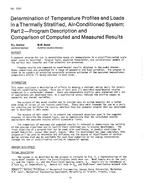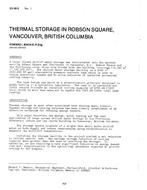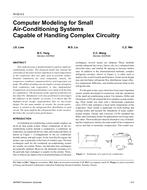Click here to purchase
A major portion of energy (~48%) in residences is consumed for air-conditioning and heating. Geothermal (water-to-air) heat pumps have proved to bemore efficient than air-to-air heat pumps, however, they still use refrigerants with high global warming potential (GWP). Carbon dioxide (CO2) is a low-GWP (GWP = 1) natural refrigerant and can be a viable option for application in heat pumps. Since the heat is rejected to circulating water attemperatures ranging from 18°C to 30°C (64.4°F to 86.0°F), the CO2 thermodynamic cycle often operates in the subcritical region, as opposed to beingsupercritical if used in an air-to-air system. The efficiency of a CO2 system is expected to be comparable to a conventional system if it is operated in thesubcritical region. In this project, a geothermal air conditioner with a 7.9 kW (26.6 kBtu/r) cooling capacity was designed and built. The expectedEER of the air conditioner was 4.94 based on the test conditions stated in the ISO 13256-1 standard. The effects of the components on the unitcapacity and EER were analyzed. A reciprocating, semi-hermetic compressor was selected to compress refrigerant. A steady-state heat exchangersimulation model was applied to design and select an evaporator with 5 mm copper tubes, and a brazed-plate heat exchanger was used for the condenser.A suction line brazed-plate heat exchanger was added to the unit to achieve a higher EER. CuFe2P alloy tubes were used as refrigerant lines toaccommodate the high-side operating pressure. Performance testing is currently underway at the National Institute of Standards and Technology (NIST).This paper reviews the design process, modeling results, and the unique manufacturing challenges required to produce a geothermal air conditioner withCO2 as the working fluid.
Citation: 2019 Annual Conference, Kansas City, MO, Conference Papers
Product Details
- Published:
- 2019
- Number of Pages:
- 9
- Units of Measure:
- Dual
- File Size:
- 1 file , 2.3 MB
- Product Code(s):
- D-KC-19-C028


